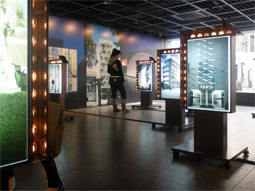 |
|
 |
| Electric signboards and photo posters |
|
Laser-etched acrylic blocks |
|
|
Twenty years ago, Astrid Klein (Italian) and Mark Dytham (British), both graduates of London's Royal College of Art, arrived in Tokyo to begin work for a young avant-garde architect named Toyo Ito. Precocious, ambitious, and prodigiously talented, within a couple of years they had gained the courage to strike out on their own as Klein Dytham architecture (KDa). Engaging the Tokyo architectural community with a skilful balance of careful deference and outrageous nerve -- a willingness to take on the tiniest commission and give it all they've got -- they have been able to stake out a unique niche in Japan. Rather than trying to compete with the local practitioners on their own terms, KDa compliment and complement, finding potential in those places that most would ignore -- some of their earliest projects were construction site hoardings for the buildings of other architects. The two of them radiate such genuine charm and good humor (it's impossible to find a photo of them where they are not both grinning), it's clear that the pleasure they take in the energizing weirdness of everyday Japan has not worn off even after twenty years. Indeed, this is the source of their inventiveness: the ability to see everything around them with an outsider's eyes.
Which isn't to say that their work is just some sort of ironic reframing of readymade banality or exotica. Rather, it reflects an almost innocent delight in every aspect of their adopted home, from the most vulgar to the most refined. The retrospective show now on at Gallery MA, "20: Klein Dytham architecture," contains not a single architectural drawing, model, or text, instead displaying photos of their buildings on the kind of cheap electric kerbside signs used by late-night noodle shops or seedy hostess clubs -- illuminated acrylic panels ringed with flashing lightbulbs. One wall of the lower hall and outdoor courtyard is lined with large photographs of the buildings, and the darkened upper hall displays rows of acrylic blocks laser-etched with KDa designs. These blocks sit along the edge of booths that house iPods containing short presentations on their various projects: every design gets twenty images shown for twenty seconds each.
Almost anyone involved with the design profession anywhere on the planet will immediately recognize the twenty-by-twenty format as that of Pecha Kucha Night, KDa's foremost contribution to contemporary design culture. Invented as a kind of rent party back when KDa were struggling to pay theirs, Pecha Kucha Night is an all-welcome, all-equal celebration of design talent that now occurs in close to 200 cities worldwide. "Twenty" has become the theme for everything KDa do, right down to the number of chapters in the exhibition catalog (entitled -FUL, the suffix of abundance, somewhat perversely it's only in Japanese -- given that most of the text must have begun life in English, there would have been little extra effort in making the book bilingual).
Amid the fun and games, the truly subversive nature of KDa's work tends to be overlooked. Their willingness to treat every project with equal respect and irreverence, and their generosity to other designers in staging Pecha Kucha Night, shows a deliberate disregard for hierarchies within a very hierarchical culture. KDa's colorful, comical designs inject unexpected smiles into often-drab urban environments, and Pecha Kucha Night gives the lowliest unknown designers equal billing with architectural superstars. It's fair to say that the buildings of KDa are unlikely to make it into the serious architectural history books, but their readiness to ignore the rules comprises a project of revolutionary social engineering -- often stealthily disguised as frivolous entertainment -- that is nothing less than brilliant.
|